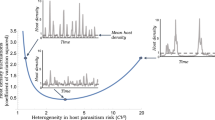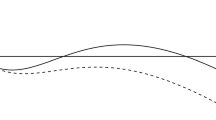Abstract
Parasitism by the Varroa mite has had recent drastic impact on both managed and feral bee colonies. This paper proposes a stochastic population dynamics model for interacting African bee colony and Varroa mite populations. Cumulant truncation procedures are used to obtain approximate transient cumulant functions, unconstrained by the usual assumption of bivariate Normality, for an assumed large-scale model. The apparent size of the variance and skewness functions suggest the importance of the proposed truncation procedure which retains some higher-order cumulants, but determining the accuracy of the approximations is problematical. A smaller-scale bee/Varroa mite model is hence proposed and investigated. The accuracy for the means is exceptional, for the second-order cumulants is moderate, and for some third-order cumulants is poor. Notwithstanding the poor accuracy of a skewness approximation, the saddlepoint approximations for the marginal transient population size distributions are excellent. The cumulant truncation methodology is very general, and research is continuing in its application to this new class of host-parasite models.
Similar content being viewed by others
References
Bailey, N.T.J. (1964) The Elements of Stochastic Processes, Wiley, New York.
Balakrishnan, N., Johnson, N.L., and Kotz, S. (1998) A note on relationships between moments, central moments and cumulants from multivariate distributions. Stat. Prob. Letters, 39, 49–54.
Banks, R.B. (1994) Growth and Diffusion Phenomena, Springer-Verlag, Berlin.
Bartlett, M.S., Gower, J.C., and Leslie, P.H. (1960) A comparison of theoretical and empirical results for some stochastic population models. Biometrika, 47, 1–11.
Daniels, H.E. (1954) Saddlepoint approximations in statistics. Ann. Math. Statist., 25, 631–50.
Daniels, H.E. (1960) Approximate solutions of Green's type for univariate stochastic processes. J. Roy. Statist. Soc., B22, 376–401.
Dennis, B., Desharnais, R.A., Cushing, J.M., and Constantino, R.B. (1995) Nonlinear demographic dynamics: mathematical models, statistical methods, and biological experiments. Ecol. Monographs, 65, 261–81.
Isham, V. (1991) Assessing the variability of stochastic epidemics. Math. Biosci., 107, 209–24.
Kaplan, J.K. (1996) Buzzing across the border. Agricultural Res., 44, 4–10.
Kraus, B. and Page, R.E., Jr. (1995) Effect of Varroa jacobsoni (Mesostigmata: Varroidae) on feral Apis Mellifera (Hymenoptera: Apidae) in California. Environ. Entomol., 24, 1473–80.
Loper, G.M. (1995) A documented loss of feral bees due to mite infestations in S. Arizona. Am. Bee J., 135, 823–4.
Marion, G., Renshaw, E., and Gibson, G. (1998) Stochastic effects a model of nematode infection in ruminants. J. Math. Appl. Med. Biol., 15, 97–116.
Martin, S. (1998) A populaton model for the ectoparasite mite Varroa jacobsoni in honey bee (Apis melliferra) colonies. Ecological Modelling, 109, 267–81.
Matis, J.H. and Kiffe, T.R. (1996) On approximating the moments of the equilibrium distribution of a stochastic logistic model. Biometrics, 52, 155–66.
Matis, J.H. and Kiffe, T.R. (1999) Effects of immigration on some stochastic logistic models: a cumulant truncation analysis. Theor. Popul. Biol., 56, 139–61.
Matis, J.H. and Kiffe, T.R. (2000) Stochastic Population Processes: A Compartmental Perspective, Springer-Verlag, New York.
Matis, J.H. and Wehrly, T.E. (1981) Compartmental models with multiple sources of stochastic variability: the one-compartment models with clustering. Bull. Math. Biol., 43, 651–44.
Matis, J.H., Kiffe, T.R., and Parthasarathy, P.R. (1998) On the cumulants of population size for the stochastic power law logistic model. Theor. Popul. Biol., 53, 16–29.
Matis, J.H., Rubink, W.L., and Makela, M. (1992) Use of the gamma distribution for predicting arrival times of invading insect populations. Environ. Entomol., 21, 436–40.
Matis, J.H., Wehrly, T.E., and Ellis, W.C. (1989) Some generalized stochastic compartmental models for digesta flow. Biometrics, 45, 703–20.
Matis, J.H., Zheng, Q., and Kiffe, T.R. (1995) Describing the spread of biological populations using stochastic compartmental models with births. Math. Biosciences, 126, 215–47.
May, R.M. (1973) Stability and Complexity in Model Ecosystems, University Press, Princeton, NJ.
Maynard Smith, J. (1974) Models in Ecology, Cambridge University Press, Cambridge, UK.
Mobus, B. and de Bruyn, C. (1993) The New Varroa Handbook, Northern Bee Books, Mytholmroyd, UK.
Morse, R.A. (1990) The ABC & XYZ of Bee Culture, 40th ed., Root Publishing.
Murray, J.D. (1993) Mathematical Biology, second edition, Springer-Verlag, New York.
Nisbet, R.M. and Gurney, W.S.C. (1982) Modelling Fluctuating Populations, Wiley, New York.
Pielou, E.C. (1977) Mathematical Ecology, second edition, Wiley, New York.
Renshaw, E. (1991) Modelling Biological Populations in Space and Time, Cambridge University Press, Cambridge, UK.
Renshaw, E. (1998) Saddlepoint approximations for stochastic processes with truncated cumulant generating functions. J. Math. Appl. Med. Biol., 15, 1–12.
Renshaw, E. (2000) Applying the saddlepoint approximation to bivariate stochastic processes. Math Bioscience, 168, 57–75.
Rowell, G.A., Makela, M.E., Villa, J.D., Matis, J.H., Labougle, J.M. and Taylor, O.R., Jr. (1992) Invasive dynamics of Africanized honeybees in North America. Naturwissenschaften, 79, 281–3.
Rubink, W.L., Luevano-Martinez, P., Sugden, E.A., Wilson, W.T. and Collins, A.M. (1996) Subtropical Apis mellifera swarming dynamics and Africanization rates in Northeastern Mexico and Southern Texas. Ann. Entomol. Soc. Am., 89, 243–51.
Rubink, W.L. (2000) Personal communication.
Smith, P.J. (1995) A recursive formulation of the old problem of obtaining moments from cumulants and vice versa. Am. Statistician, 49, 217–8.
Spivak, M., Fletcher, D.J.C. and Breed, M.D. (1991) The “African” Honey Bee, Westview, Boulder, CO.
Texas Agricultural Experiment Station, (1998) The Texas Honey Bee Research and Management Plan. College Station, TX.
Whittle, P. (1957) On the use of the Normal approximation in the treatment of stochastic processes. J. Roy. Statist. Soc., B.19, 268–81.
Wolfram, S. (1991) Mathematica, A System for Doing Mathematics by Computer, second edition, Addison-Wesley, Redwood City, CA.
Author information
Authors and Affiliations
Rights and permissions
About this article
Cite this article
Matis, J.H., Kiffe, T.R. On interacting bee/mite populations: a stochastic model with analysis using cumulant truncation . Environmental and Ecological Statistics 9, 237–258 (2002). https://doi.org/10.1023/A:1016288125991
Issue Date:
DOI: https://doi.org/10.1023/A:1016288125991




